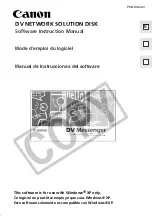
T01NCLT3
Set NC attenuation level on input channel T to
3 dB.
T01NCLT3
T01NCLT?
Query the NC attenuation level on input
channel T.
T01NCLTx
, where
x
is a number between
0 and 20, depending on the current
setting of the NC attenuation level on
input channel T.
8.75.
NVINIT
-- Reinitialize Non-Volatile Memory
This command reinitializes (or formats) all non-volatile memory settings. This will effectively erase
settings for global settings, user presets, macros, labels, and logic I/O configurations. This will basically
reset the unit to a "fresh-out-of-the-box" state.
When this command is issued, it writes to non-volatile memory in order to format the contents back to
the factory default state. The writing process results in a short delay. After the non-volatile memory has
been reformatted, the Vortex will perform a software reset, which is equivalent to a power cycle.
Example
Description
Status Message
T01NVINIT
Reinitialize non-volatile memory and perform a
software reset.
No status message will be generated.
There will be a short delay and then the
Vortex will reset.
8.76.
NVLOCK
-- Lock/Unlock Non-Volatile Memory
This command controls the non-volatile memory lock feature. When
NVLOCK
is enabled, the user may
not save any system settings to non-volatile memory. This includes global parameters, presets, macros,
labels, and logic assignments. The lock applies whether the user tries to make the changes via RS-232,
front panel, logic inputs, or any other method. The user will still be able to query all the features of the
device, but will get an error message if an attempt is made to change them. When
NVLOCK
is disabled,
the user has full access to the system settings.
Usage of this command is similar to other boolean commands (see
Section 6.1
) except that when
disabling this feature, the password must be supplied for the command to work. If an incorrect
password is supplied, '
ERROR#005
' will be generated. The examples below illustrate the correct usage.
The examples assume that the password has been set to '
aspi
' (the default). The
NVLOCK
password
can be changed via the
NVPSWD
command.
This command is saved to global non-volatile memory and is not part of a preset. Its value is saved
each time it is changed. It will retain its value after power-down. Since this command writes to non-
volatile memory, there will be a delay before an acknowledgment is returned.
Example
Description
Status Message
T01NVLOCK1
Lock the non-volatile memory to
prevent users from changing the
settings.
T01NVLOCK1
















































